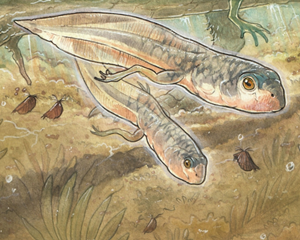A newly discovered frog fossil represents the oldest tadpole ever found, and it looks remarkably like the tadpoles you're probably familiar with except for one thing -- it was a giant.
一個新發(fā)現(xiàn)的蛙類化石,是到目前為止所找到的最古老的蝌蚪,而且看起來跟你可能很熟悉的蝌蚪很像,只有一件事例外--它個頭超大。
Paleontologist Federico Agnolín and his colleagues discovered the fossil by accident.
古生物學家費德里格·安諾林和同事找到這個化石完全是意外。
The team had been scouring the same quarry at Estancia La Matilde in the Santa Cruz province of Argentina for dinosaurs.
他們的團隊已經(jīng)在阿根廷圣克魯斯省的拉爾瑪?shù)龠_莊園的一個采石場搜尋了許久。
They hoped that the fine sediment and volcanic ash that formed the quarry's Jurassic-period rock may have preserved the imprint of soft tissues never discovered before.
形成這片采石場侏羅紀巖石的是細致的沉積物和火山灰,他們原本希望里面能留下以前從未發(fā)現(xiàn)過的軟組織印痕。
Yet instead of dinos, they kept finding frogs.
然而,他們發(fā)現(xiàn)的不是恐龍,而是青蛙。
The frogs were all adults from the same extinct species, Notobatrachus degiustoi.
這些蛙都是同一個已滅絕蛙類Notobatrachus degiustoi的成蛙。
That led some researchers to speculate that perhaps in those days, frogs didn't have a tadpole stage yet.
這也讓某些研究人員開始懷疑,或許那個年代的蛙類是不會經(jīng)過蝌蚪階段的。
Yet in January 2020, a team member picked up a rock during a break and found a more than six inches long imprint of a tadpole revealing exquisite details of its gills, eyes, and even some nerves.
但在2020年1月,一名團隊成員在休息時段撿起了一塊石頭,結(jié)果發(fā)現(xiàn)了一個超過6英寸長的蝌蚪印痕,上面的細節(jié)非常細致,包括鰓、雙眼,甚至還有一些神經(jīng)。
The researchers who described the fossil in Nature today estimate it to be between 161 to 168 million years old, beating the previous record holder by around 30 million years.
在10月30日的《自然》期刊上描述了這塊化石的研究人員估計,這塊化石約有1億6100萬年到1億6800萬年的歷史,比之前的紀錄保持化石還老了大約3000萬年。

The find provides solid evidence frogs have had a tadpole stage for at least that long.
這項發(fā)現(xiàn)提供了確鑿的證據(jù),證實蛙類有蝌蚪階段至少已經(jīng)有那么久了。
"It's a beautiful confirmation of what many experts had suspected," says herpetologist Alexander Haas of the Leibniz Institute in Bonn, Germany.
“這完美地證實了許多專家懷疑的事情。”德國波昂布萊尼茲研究所的爬蟲學家亞歷山大·哈斯說。
Reconstructing tadpole evolution based on their diversity today, Haas and others previously predicted that tadpoles would have existed this early on.
哈斯目前正根據(jù)蝌蚪的多樣性重建它們的進化過程,他之前就曾和其他學者預測,在那么早的年代已經(jīng)有蝌蚪的存在了。
Since he wasn't an expert in frogs himself, Agnolín sought help from biologist Mariana Chuliver, who like him is based at the Fundación Félix de Azara in Buenos Aires, Argentina, and had studied tadpole development in frogs before.
因為本身不是蛙類專家,所以安諾林去尋求生物學家瑪麗安娜·楚利維的協(xié)助,他們一樣都是在阿根廷布宜諾斯艾利斯的菲利克斯·德阿扎拉基金會工作,但楚利維之前就研究過蛙類的蝌蚪發(fā)育。
When looking at the fossil under the microscope, she found the cartilage supporting its gills to be surprisingly similar to that of tadpoles alive today.
在顯微鏡下檢視該化石的時候,她發(fā)現(xiàn)支撐著鰓的軟骨組織跟現(xiàn)存的蝌蚪驚人地相似。
Like its present-day brethren, tadpoles of this extinct species would have sucked in water and then pushed it out across their gills, filtering out food and absorbing oxygen all in one go.
這個已滅物種的蝌蚪,就和現(xiàn)在的同類蝌蚪一樣,是把水吸進來之后再經(jīng)過鰓往外擠出去,過濾食物和吸收氧氣同時搞定。
This suggests it probably wasn't feeding on the small shellfish, insects and crustaceans also found as fossils in these rocks, but rather on micro-organisms and organic debris floating in the water, says Chuliver.
楚利維稱,這表明它吃的可能不是同樣在這些巖石中發(fā)現(xiàn)的小型貝類、昆蟲和甲殼類,而是微生物和水中漂浮的有機碎屑。












